So I'm creating a GUI that represents a vending machine. I'm just running into some problems trying to get the layout to work the way I want it. My thought was to insert an image into a JLabel, and then overlay that image with transparent JButtons in specific locations so that when you click on the image in certain locations, it will trigger the JButton. I haven't gotten to the transparency yet as I'm currently stuck on how to get the JButtons precisely where they need to be.
I've tried setLocation and setBounds with no luck. Any help on how to exactly position the jbuttons over the possible vending machine choices would be great.
import javax.swing.*;
import javax.imageio.*;
import java.awt.*;
import java.awt.event.*;
import java.awt.image.*;
import java.io.*;
public class vendMachine extends JFrame
{
//Frame Dimensions
private static final int FRAME_HEIGHT = 800;
private static final int FRAME_WIDTH = 800;
private JPanel totalGUI, imagePanel, coinPanel;
public vendMachine()
{
createComponents();
setSize(FRAME_WIDTH, FRAME_HEIGHT);
setTitle("Vending Machine");
}
private void createComponents()
{
try
{
BufferedImage machineImg = ImageIO.read(new File("images/pepsivend.jpg"));
JLabel machineImgLabel = new JLabel(new ImageIcon(machineImg));
machineImgLabel.setLayout(new FlowLayout());
JButton test = new JButton("TEST BUTTON");
machineImgLabel.add(test);
//test.setBounds(0,0,0,0);
ImageIcon pennyIcon = new ImageIcon("images/coins/penny.jpg");
JButton pennyButton = new JButton(pennyIcon);
ImageIcon nickelIcon = new ImageIcon("images/coins/nickel.jpg");
JButton nickelButton = new JButton(nickelIcon);
ImageIcon dimeIcon = new ImageIcon("images/coins/dime.jpg");
JButton dimeButton = new JButton(dimeIcon);
ImageIcon quarterIcon = new ImageIcon("images/coins/quarter.jpg");
JButton quarterButton = new JButton(quarterIcon);
coinPanel = new JPanel();
coinPanel.setLayout(new GridLayout(4,1));
coinPanel.add(pennyButton);
coinPanel.add(nickelButton);
coinPanel.add(dimeButton);
coinPanel.add(quarterButton);
totalGUI = new JPanel();
totalGUI.setLayout(new BorderLayout());
totalGUI.add(machineImgLabel, BorderLayout.CENTER);
totalGUI.add(coinPanel, BorderLayout.EAST);
}
catch (IOException e)
{
e.printStackTrace();
}
add(totalGUI);
}
}
In the above Image I would like some help on how to get the test button, to overlay on top of the pepsi selection. From there I can go about making it transparent and removing the borders and text.
Edited to add: none of the buttons do anything yet. Simply trying to get the layout going before adding in anything else

